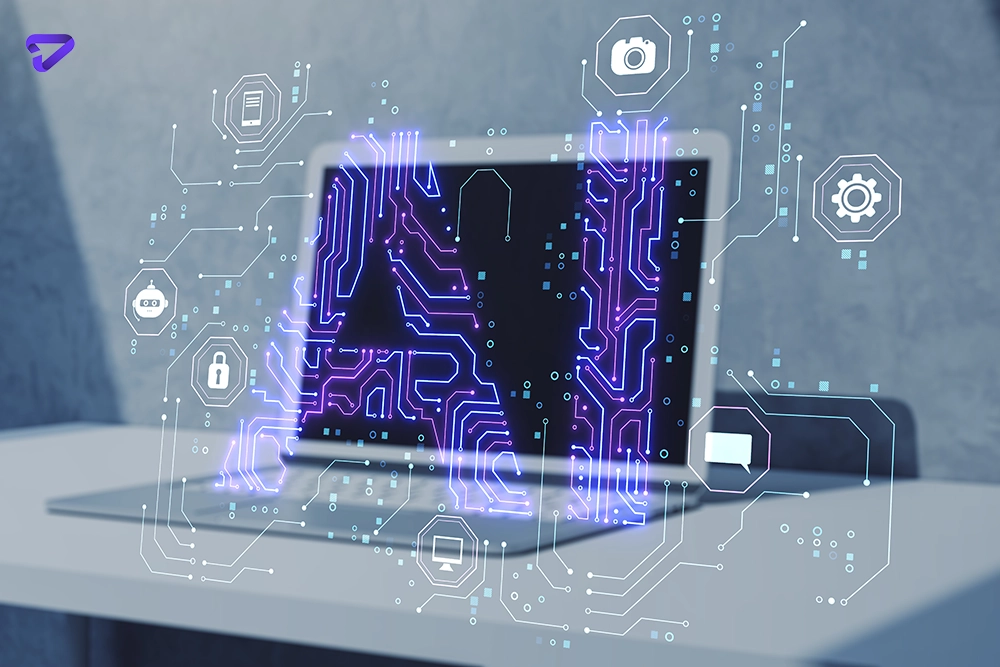
How AI is Revolutionizing Web Design: Tools and Techniques
Introduction
In today’s digital age, web design plays a crucial role in attracting and engaging online audiences.
With the rapid advancements in artificial intelligence (AI), web designers are now equipped with powerful tools and techniques that revolutionize the way websites are created and optimized.
In this article, we will explore how AI is transforming the field of web design, the tools available, and the techniques employed to enhance user experiences.
Understanding AI in Web DesignWhat is AI?
Artificial Intelligence, or AI, refers to the development of computer systems that can perform tasks that typically require human intelligence.
In web design, AI technologies enable machines to analyze data, make decisions, and automate various aspects of the design process.
How AI is applied in web design
AI in web design is applied in several ways, including:
- Automation of repetitive tasks: AI-powered tools can automate repetitive tasks such as coding, resizing images, and optimizing layouts. This saves time for designers, allowing them to focus on more creative aspects of the design process.
- Personalization and user experience enhancement: AI algorithms analyze user behavior, preferences, and demographics to deliver personalized web experiences. By tailoring content, recommendations, and layouts to individual users, websites can engage visitors more effectively and increase conversions.
- Data-driven decision making: AI enables designers to make data-driven decisions by analyzing large volumes of user data and generating insights. This helps in identifying trends, optimizing user flows, and improving overall website performance.
Benefits of using AI in web design
The integration of AI in web design offers several benefits, including:
- Efficiency: AI-powered tools automate time-consuming tasks, allowing designers to work more efficiently and produce high-quality websites faster.
- Improved user experiences: AI enables personalized experiences, resulting in higher user engagement and conversions.
Data-driven decision making: AI-powered analytics provide valuable insights into user behavior, enabling designers to make informed decisions and optimize websites for better performance.
AI-Powered Web Design Tools
AI has given rise to a new generation of web design tools that streamline the design process and empower designers to create visually stunning and user-friendly websites. Some notable AI-powered web design tools include:
AI-based website builders
AI-based website builders leverage machine learning algorithms to simplify the website creation process. These tools offer intuitive interfaces, drag-and-drop functionality, and pre-designed templates that can be customized to suit specific requirements. They utilize AI to suggest design elements, layouts, and color schemes based on the user’s preferences and industry standards. Examples of popular AI website builders include Wix ADI, Squarespace, and Weebly.
AI-driven design platforms
AI-driven design platforms combine the power of AI with human creativity to generate unique and appealing designs.
These platforms use AI algorithms to analyze design trends, user preferences, and branding guidelines to assist designers in creating visually captivating layouts.
By automating repetitive design tasks and providing intelligent recommendations, these platforms enhance the productivity and creativity of designers. Noteworthy AI design platforms in the market include Canva, Adobe Sensei, and Sketch2React.

AI Techniques in Web Design
AI techniques are reshaping the landscape of web design, enabling designers to create more intuitive and user-centric websites. Let’s explore some key AI techniques used in web design:
Predictive analytics in web design
Predictive analytics utilizes AI algorithms to analyze user behavior patterns and predict user preferences. By analyzing data such as browsing history, click-through rates, and purchase behavior, websites can deliver personalized experiences tailored to individual users. This technique helps designers understand user needs and preferences, allowing them to create targeted content and optimize user flows.
For example, an e-commerce website can use predictive analytics to recommend products based on a user’s browsing and purchase history.
By understanding the user’s preferences, the website can display relevant products, increasing the likelihood of a purchase.
Natural Language Processing (NLP) in web design
Natural Language Processing (NLP) is a branch of AI that enables machines to understand and process human language. In web design, NLP is used to enhance user interactions and improve search functionality.
One application of NLP in web design is the use of chatbots and virtual assistants.
These AI-powered conversational interfaces can engage users in real-time conversations, providing assistance, answering queries, and guiding users through the website.
By integrating NLP algorithms, chatbots can understand user intents and respond intelligently, creating a more personalized and interactive experience.
Another application is improving search functionality through NLP. By analyzing search queries and understanding user intent, NLP algorithms can deliver more accurate search results, improving the overall user experience.
Image recognition and visual search
AI-powered image recognition technology is transforming the way visual content is utilized in web design.
By analyzing images and identifying objects, colors, and patterns, AI algorithms can automatically tag and categorize visual content, making it easier to manage and optimize.
Visual search is another powerful application of image recognition in web design.
It allows users to search for similar images or products by uploading an image or using a camera to capture an image.
AI algorithms analyze the visual features of the image and retrieve relevant results, enhancing the user experience and facilitating discovery.
For example, an e-commerce website can implement visual search functionality, enabling users to find similar products by simply uploading an image. This not only simplifies the search process but also provides a visually immersive shopping experience.
These AI techniques leverage the power of data and automation to enhance user experiences, optimize design elements, and streamline the web design process.
Next, let’s explore real-world case studies that demonstrate the impact of AI in web design.

Case Studies: Real-World Examples of AI in Web Design
To truly understand the impact of AI in web design, let’s take a look at a couple of real-world case studies that highlight the successful implementation of AI techniques:
Case Study 1: AI-driven website personalization
Company XYZ, an e-commerce platform, implemented AI-powered website personalization to enhance user experiences and increase conversions.
By analyzing user behavior data, including browsing history, purchase patterns, and demographic information, AI algorithms were able to deliver personalized product recommendations, tailored content, and customized layouts.
The results were significant. Users who experienced personalized recommendations showed a 30% increase in conversion rates compared to those who did not.
The average order value also rose by 20%, indicating that the personalized experiences resonated with users and drove higher engagement and sales.
The implementation of AI-driven website personalization allowed Company XYZ to create a more engaging and tailored experience for their users, resulting in improved customer satisfaction and business growth.
Case Study 2: AI-powered design platform for efficient web design
Design Studio ABC adopted an AI-powered design platform to streamline their web design process. The platform utilized AI algorithms to automate repetitive design tasks such as resizing images, suggesting layouts, and optimizing color schemes.
The AI-powered design platform significantly increased the efficiency of Design Studio ABC. By automating time-consuming tasks, designers were able to focus more on creative aspects, resulting in faster turnaround times and higher-quality designs. The platform also provided intelligent recommendations based on design trends and user preferences, allowing designers to create visually captivating layouts with ease.
Design Studio ABC reported a 40% reduction in design production time and a 20% increase in client satisfaction since implementing the AI-powered design platform. The combination of AI algorithms and human creativity resulted in more efficient and visually appealing web designs.
These case studies demonstrate the tangible benefits of integrating AI techniques in web design. From personalized user experiences to streamlined design processes, AI is revolutionizing the way websites are created and optimized.

Future Trends and Challenges in AI Web Design
As AI continues to evolve, it is expected to shape the future of web design in various ways. Let’s explore some emerging trends and the challenges that lie ahead:
Emerging trends in AI and web design
- Voice user interfaces and AI assistants: With the rise of voice-activated devices and virtual assistants like Amazon Alexa and Google Assistant, voice user interfaces (VUI) are becoming more prevalent. AI-powered VUIs enable users to interact with websites using voice commands, opening up new possibilities for hands-free browsing and navigation.
- AI-generated content and design recommendations: AI algorithms are becoming increasingly sophisticated in generating content and design recommendations. From automated copywriting to layout suggestions, AI-powered systems can assist designers in creating compelling content and visually appealing designs.
Ethical considerations and challenges in AI web design
While AI offers numerous benefits to web design, it also poses ethical considerations and challenges that need to be addressed:
- Ensuring transparency and accountability: AI algorithms can be complex and opaque, making it challenging to understand how design decisions are made. It is crucial to ensure transparency in AI systems to gain users’ trust and allow for accountability.
- Addressing biases and ethical concerns in AI algorithms: AI algorithms are trained on vast amounts of data, which may contain biases and perpetuate inequalities. It is essential to address these biases and ethical concerns to ensure fair and inclusive web design practices.
By staying aware of emerging trends and addressing ethical challenges, the integration of AI in web design can continue to advance while maintaining ethical standards.

Conclusion
AI is undeniably revolutionizing web design, empowering designers with powerful tools and techniques to create personalized, efficient, and visually stunning websites.
Through automation, personalization, and data-driven decision making, AI is transforming the way websites are designed and optimized.
From AI-powered web design tools like website builders and design platforms to AI techniques such as predictive analytics, natural language processing, and image recognition, the possibilities for AI in web design are vast.
Real-world case studies demonstrate the tangible benefits of implementing AI, including improved user experiences, increased conversions, and streamlined design processes.
As we look to the future, emerging trends like voice user interfaces and AI-generated content hold promise for further advancements in web design.
However, it is vital to address ethical considerations and challenges to ensure the responsible and inclusive use of AI in web design.
By embracing the power of AI and staying informed about its latest developments, web designers can unlock new opportunities and deliver exceptional web experiences.
The revolution of AI in web design has only just begun, and the possibilities are endless.








